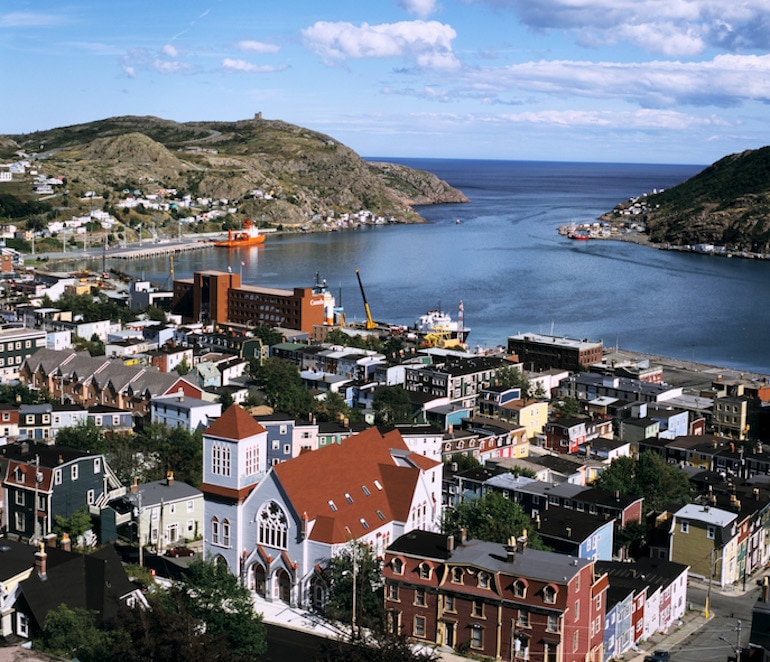
Downtown St. John’s and it’s Atlantic Ocean harbor
By Liz Campbell
The taxi driver greets me with, “How’s she gettin’ on?” (How are you?), then introduces himself, “Call me Andy, m’luv.” Firm friendship established, Andy and I cheerfully chat on the way in from the airport at Deer Lake, Newfoundland. When a comment of mine evokes a great belly laugh, he sputters, “I dies at you,” (you’re funny).
This is Newfoundland English, affectionately called Newfinese. A wonderfully expressive patois, it has its own dictionary and a wide variety of expressions to challenge the most agile mind. The standard greeting is “Whattaya at?” (What’s happening?), to which the usual response is “D’is is it” or, as Andy adds with a laugh, “If you’re at work, the answer is probably, ‘Nuttin’ b’y’!” Note that b’y might have started as boy, but it’s actually gender neutral now.
Curious and compelling lingo
Someone who is upset might have a ‘face like a boiled boot’ and a muggy, foggy day is ‘mauzy’. Hungry? In Newfinese, you’re ‘gut-foundered’. Lost? You might be told to “stay where you’re at ‘til I comes where you’re to.”
The people of Newfoundland, with their distinctive blend of West Country English/Irish/French accent, are charming. The Blarney Stone’s effects clearly are imbedded in the Irish genes. Their friendliness is legendary, welcoming each ‘come from away’ (someone not from Newfoundland) with warmth and good humor.
Andy is quick to let me know that his province is pronounced newfin-land (NOT new-found-land and NOT newfin-lind). It may seem trivial but Newfoundlanders take it seriously. In1876, John Peter Davis actually whipped out his six-shooter and killed William Atcheson during an argument about the pronunciation of Newfoundland. They were in Colorado at the time!
Newfoundland was home to the first English speaking colony of Britain in Canada, 300 years before it became part of the country in 1949. It was the last province to join, and in 2001, the Constitution was amended to change its name to Newfoundland and Labrador. But Canada’s youngest province is actually its oldest in some ways.
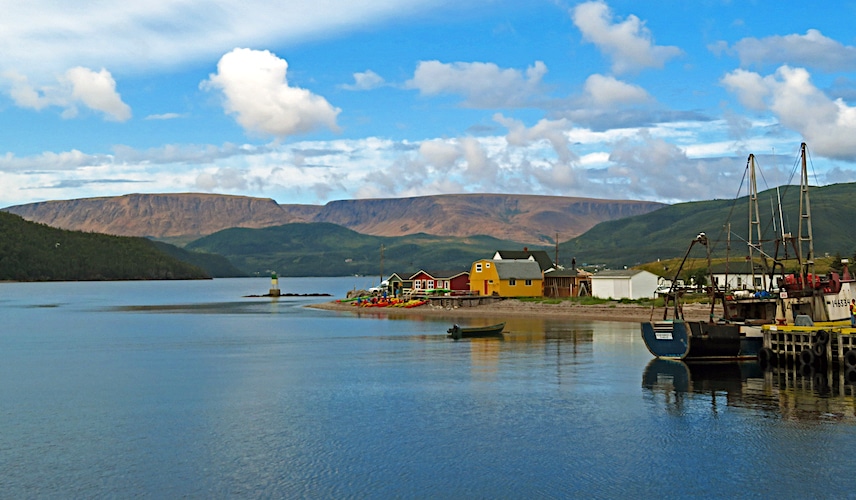
The bare, iron-rich stone of the Tablelands rise above the green hills of Gros Morne National Park in Western Newfoundland.
Nicknamed ‘The Rock’, much of Newfoundland is composed of a mixture of bogs, barrens, and rocky outcrops. As a result, many parts of the island don’t easily support agriculture. Indeed, nothing at all grows on the iron and mineral rich rock of The Tablelands in Gros Morne National Park, whose unique geological composition has made it a UNESCO World Heritage site. Located at the foot of the Long Range Mountains on the shore of the Gulf of St. Lawrence, the rock in Gros Morne is more than 3,800 million years old, some of the oldest on the planet!
Through geologic ages, glaciers cut through Gros Morne creating spectacular vistas of coastal lowland, alpine plateaus, and striking fiords with sheer cliffs. But The Tablelands is unique. It’s one of a very few places where the earth’s mantle has actually pushed up through the outer crust of the planet.
Also within Gros Morne is Western Brook Pond. The tour boat which sails into this fjord gives spectacular views of steep rock walls 2,000-ft high. Eat your heart out, Norway! The multi-colored stone of these cliffs is punctuated with cascading water. One of these, Pissing Mare Falls at 1,150-ft, is one of the highest waterfalls in eastern North America, and its name provides another delightful example of Newfoundland humor.
Place names in Newfoundland are often quirky. Imagine announcing that you’re from Come by Chance, or Blow Me Down, or Happy Adventure, or Dildo (which probably refers to the oar pegs in a dory), or Quidi Vidi (pronounced Kiddy Viddy), or Witless Bay. Each has a unique explanation – or three – as to the origin of their name. But as most of the names are centuries old, dating to the early settlers, some of these explanations are pure conjecture. But who wouldn’t love to tell people they hail from Heart’s Desire, or Heart’s Delight, or Heart’s Content, three towns along the same stretch of Trinity Bay coastline as Dildo.

A waterfall spills down the steep rock face at Western Brook Pond Courtesy Newfoundland and Labrador
The first settlers
Indigenous people have lived in the Newfoundland and Labrador region for more than 10,000 years. The advent of extensive European settlement resulted in significant changes to the traditional way of life for the Beothuk, who once lived primarily along the island’s coast. Sadly, exposure to European diseases ultimately resulted in the demise of this community.
The Mi’kmaq, a traditionally semi-nomadic people, made seasonal trips throughout Atlantic Canada and northern New England to hunt, trap and fish. The site of the present-day Mi’kmaq reserve in Newfoundland, Miawpukek, was a popular semi-permanent campsite.
The first known evidence of European presence in the Americas can be found in Newfoundland. More than 500 years before Columbus arrived on the continent, Leif Erikson wintered at a settlement called Straumfiord – also known as Leif’s Camp – on a grassy terrace near L’Anse aux Meadows.
Here, the Vikings built a small community of sod and timber buildings. Little is known about how long they remained. But the remains of the first iron works in the New World can be seen here, as well as an original nail found at the site.
Declared a UNESCO World Heritage Site in 1978, L’Anse Aux Meadows offers a glimpse into what life might have been like back then. Those first Vikings would have found some familiar wild foods like chanterelle mushrooms and cloudberries, which Newfoundlanders call bakeapples. But then, as now, the people who settled here quickly discovered that farming was going to prove a challenge. So they became adept at fishing and foraging.
Gone fishin’
No visit to Newfoundland is complete without a fishing trip. From Cox’s Cove in Western Newfoundland, Darren Park takes us out in a traditional dory. We’re cod jigging – line fishing. My haul: two tiddlers (small fish) and one large cod. Just call me the cod whisperer.
Following government regulations, we toss the fish back. Atlantic cod in the waters off Newfoundland’s northeast coast have been in the critical zone since the early 1990s. In 1992, the federal government announced a moratorium on cod fishing, instantly abolishing a traditional livelihood for 30,000 Newfoundlanders.
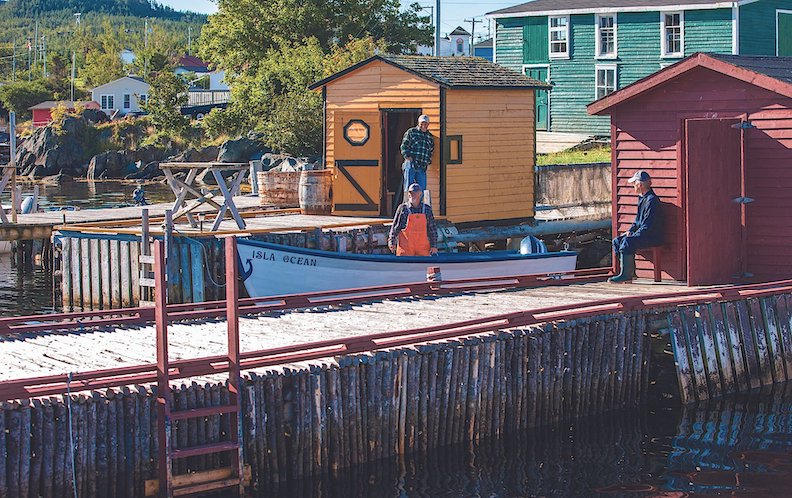
Newfoundland fishermen. Photo courtesy of Newfoundland and Labrador
Today, there’s a small commercial cod fishery, known as the “stewardship” fishery. But catch limits set at a fraction of the hundreds of thousands of tonnes landed in the late 1980s. Unfortunately, stocks remain low and restrictions on fishing remain.
Park throws one of the fish in a large arc far from the boat. He’s done this before. A circling eagle promptly dives to scoop it up, taking it to a nearby rocky beach. Lunch is served.
Once a commercial fisherman himself, Park started Four Seasons Tours a few years ago and takes his new role as guide seriously. He steers our boat along the shoreline and explains why Newfoundland’s geologic composition is so significant. “It’s because of the rocks in Newfoundland that scientists discovered plate tectonics,” he explains. “The rock here actually comes from two continents which collided millions of years ago, pushing up the Appalachian Mountains in North America.”
It’s not his traditional livelihood, but he has embraced his new career. “I meet people from all over the world, and I share a little about my home,” he says. “Life’s good.”
We stop at a nearby beach, and Darren builds a fire for a Newfoundland tradition – the ‘beach boil-up’. Inside the large pot, fresh mussels from the sea and “just a drop of sea water” – the traditional Newfoundland recipe – are cooked over an open fire. The sweet, salty flavor is irresistible, and sitting on a beach nibbling on the ocean’s bounty, it’s hard to disagree with this fisherman. Life is good, indeed.
Foraging the land
Near the capital city, St. John’s, Lori McCarthy of Cod Sounds stands on a stretch of the Avalon Peninsula. I see a deserted beach, but this chef turned forager sees a grocery.
Within 20 minutes we’ve collected tangy sea rocket, chuckly pear (Saskatoon berries), bakeapples (cloudberries), beach peas, firm goose tongue stalks, blueberries, and much more. Lunch starts with a cup of wild mint tea boiled on the open fire.
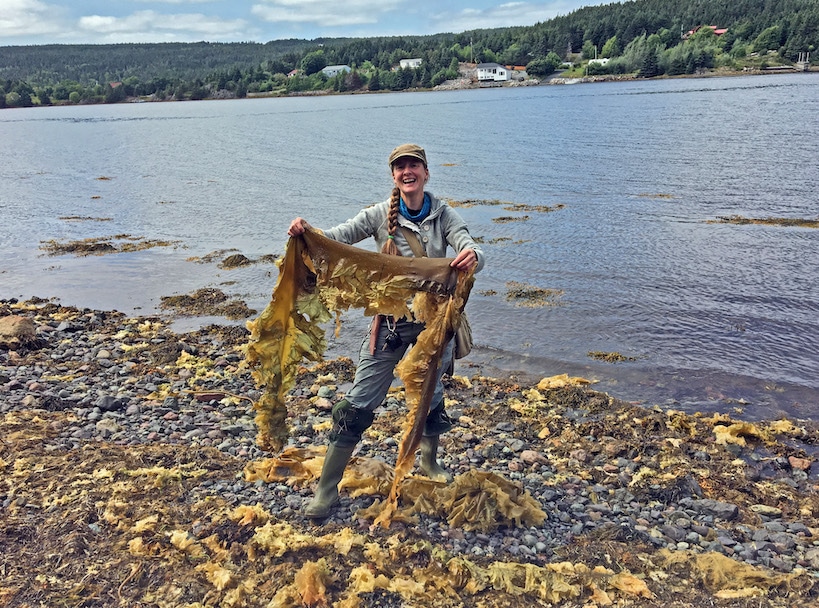
Lori McCarthy of Cod Sounds havests sugar kelp off an Avalon Peninsula beach outside St. John’s.
Thin slices of fresh sweet scallops are just warmed through on a hot rock over the flames, and given a gourmet touch with the foraged tiny blue blossoms of the heal-all plant, growing nearby. Strips of wild moose steak McCarthy brought along are skewered on branches of aromatic sweet gale and grilled over the flames. The sweet gale gives the meat a wonderful sage flavor. Fish is wrapped in strips of sugar kelp, gathered by the shore, to be steamed on the fire. All this occurs while slices of wild carrot are cooking in a frying pan. It’s a feast!
Foraged food remains traditional fare for the people of this island province. A fourth generation Newfoundlander, McCarthy is determined to foster and preserve this aspect of her island’s culinary history. So she is careful to explain the rules of foraging. “Only take a third of one plant and a third of the plants in the area as far as your eyes can see,” she says. “That way, you don’t deplete them.”
As more and more chefs strive for authentic local flavors, it’s not unusual to find ingredients like chanterelles, nettles, wild greens and wild moose in restaurants around the province. “Newfoundland is one of the only places you can get real wild game in restaurants,” says McCarthy. “Most places it’s called wild, but it’s farmed.”
Reviving these traditions is not only a source of food, but has also provided income for many in an oft beleaguered provincial economy.
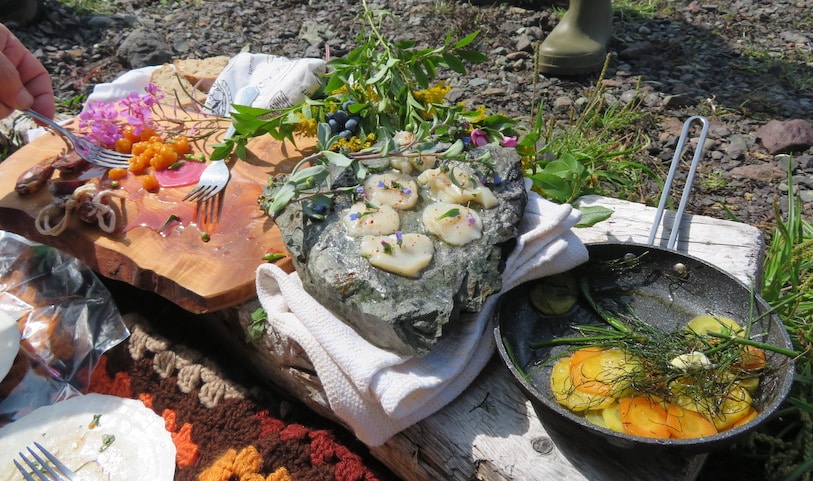
Foraging on the Avalon Peninsula produces a lunch of scallops, wild carrots and different kinds of berries.
It’s called Screech for a reason
While food was fished and foraged and sometimes farmed, the source of drink was mostly foreign, at least at the outset. Newfoundland’s famous beverage, Screech, began about 250 years ago with kegs of harsh, no-name rum from Jamaica, traded by sailors from the West Indies for salted cod. Eventually, the government of Newfoundland decided to bottle it.
During the war, locals would tease American sailors stationed alongside Canadians at Gander and Goose Bay, by offering them slugs of their rum. The legend goes that one hapless sailor gulped a straight shot of the harsh alcohol, and let out a screech. Thus, courtesy of an American, Newfoundland’s rum was named.
One of the province’s most unforgettable ceremonies is the Screech-in. It’s an opportunity for a Come From Away (CFA) to officially become a ‘Temporary Newfoundlander’. They’ll tell you it’s an age old tradition, but it’s really only about 50 years old, and not surprisingly, seems to have evolved in pubs in St. John’s. However it started, it’s a ritual worthy of the most outlandish secret society, and lots of fun.
The Screech-in requires lively music, a dead (often frozen) whole cod, and, of course, a slug of Screech. To my mind, this last is worse than the cod, though some people actually like the taste of the fiery, rough alcohol.
My own Screech-in is aboard a boat in Bonne Bay, situated in the heart of Gros Morne National Park. The boat tour features live traditional music, and Wayne Parsons, an extraordinary storyteller wearing yellow fishing gear and an old Sou’wester.
“Is ye a Screecher?” demands Parsons. I solemnly reply, “Deed I is, me old cock, and long may your big jib draw!” Translation: Indeed, I am, my old friend, and may the wind always fill your sails!”
Kissing the Cod
The next step is to kiss the cod, and drink a shot of Screech. The final step is to analyse which of the last two was most unpleasant!
The Screech-in is a must when you visit Newfoundland. Even the late Anthony Bourdain was screeched in at Christian’s Pub in St. John’s when he visited the province in 2017 for an episode of his CNN travel series, ‘Parts Unknown.’
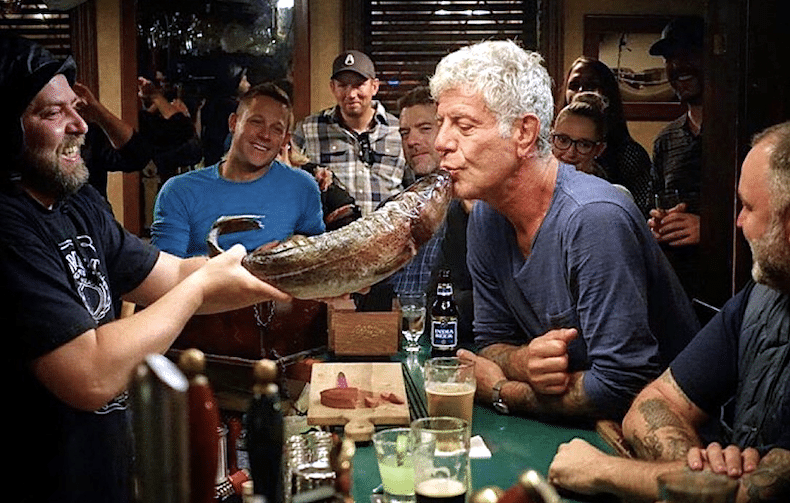
Anthony Bourdain kisses the cod at Christian’s Pub in St. John’s
By the way, don’t say you’re an honorary Newfie. The majority of Newfoundlanders accept the term Newfie with good grace, and some younger residents even proudly declare themselves Newfies. But its history as a pejorative term – all those Newfie jokes – has left many locals with a dislike of the moniker.
Rick Mercer, Canada’s favorite Newfoundlander, is a comedian, television personality, political satirist and author. He sums it up perfectly, “We have a long, colorful tradition of story-tellers here. Everyone’s grandfather – my own included – could be counted on to make us laugh, cry and have nightmares for weeks. They could regale us with stories of fishing disasters, sealing disasters, shipping disasters, and when the Yanks were here during the war. We love a joke, but be warned! What we don’t like is the Newfie joke!”
Come from Away
In 2001, Newfoundlanders won the respect of the world. During 9/11, when planes were forced to land all over North America, a total of 38 planes carrying 6,579 passengers and crew landed in Gander, Newfoundland, a community of fewer than 10,000. With typical generosity the tiny community made a place for the stranded passengers in their schools, gyms, churches, community centre, their own homes, and in their hearts.
For security reasons, the passengers weren’t allowed to retrieve their own checked luggage; the local Walmart soon ran out of clothing, especially underwear! Food was shared. The generosity of this tiny community drew effusive tributes from around the world.
The story inspired a Broadway musical, Come from Away. The Tony Award-winning musical is uplifting – filled with joy and sadness, with humor and affection. And the friendships forged by the Newfoundlanders with their mostly American visitors have been long-lasting.
You don’t have to be stranded here to enjoy that same hospitality. Indeed, few visitors leave Newfoundland without a feeling of warmth and affection for the people they’ve encountered in Canada’s oldest, youngest province.
Liz Campbell can be found at Fork on the Move. Her last story for East-West News was on Costa Rica.

